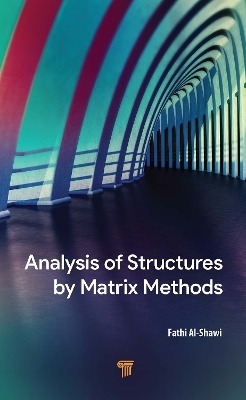
Analysis of Structures by Matrix Methods
Seiten
2023
Jenny Stanford Publishing (Verlag)
978-981-4968-19-5 (ISBN)
Jenny Stanford Publishing (Verlag)
978-981-4968-19-5 (ISBN)
This book deals with the analysis of engineering structures that are made of skeletal members and covers the types of structures that are commonly used in practice. It can be used as a textbook by undergraduate and postgraduate students studying for a degree in civil, structural, or mechanical engineering.
The analysis of engineering structures has always been a challenge to engineers, and in the past, classical methods were used to quantify the response of a structure to the applied forces. These methods were suitable for the analysis of relatively simple structures that could be solved by hand calculations but complicated structures had to be simplified to a model that could be solved by classical methods. The results, however, were approximations depending on the modifications made to the structure as well as on the experience and judgement of the analyst. These limitations led to the derivation of the slope-deflection equations for continuous beams, and later, formulation of the moment distribution method. With the advent of electronic computers, systematic procedures for the analysis of structures have been developed. Computer programs help in obtaining required solutions to the simultaneous equations in the case of structures where the number of equations is large and hand calculations are not suitable. The detailed work with simultaneous equations can be made in a general and compact form by using matrix notation, leading to the development of the matrix methods of structural analysis.
This book deals with the analysis of engineering structures made of skeletal members and covers the type of structures that are commonly used in practice. It builds up on the subject matter dealing with matrix algebra, analysis of bar elements, special forms of members, stability and vibration of structures, and pin-connected, rigid-plane, and 3D frames. It treats the important step of formulating the overall stiffness matrix of a structure in a systematic and straightforward manner and uses simple mathematical approaches wherever possible. The book is reader friendly, particularly for beginners who have no prior knowledge in this subject and can also be used as a textbook by undergraduate and postgraduate students studying for a degree in civil, structural, or mechanical engineering as well as by practicing engineers who have not studied this subject but are using software packages that deal with the analysis of engineering structures.
The analysis of engineering structures has always been a challenge to engineers, and in the past, classical methods were used to quantify the response of a structure to the applied forces. These methods were suitable for the analysis of relatively simple structures that could be solved by hand calculations but complicated structures had to be simplified to a model that could be solved by classical methods. The results, however, were approximations depending on the modifications made to the structure as well as on the experience and judgement of the analyst. These limitations led to the derivation of the slope-deflection equations for continuous beams, and later, formulation of the moment distribution method. With the advent of electronic computers, systematic procedures for the analysis of structures have been developed. Computer programs help in obtaining required solutions to the simultaneous equations in the case of structures where the number of equations is large and hand calculations are not suitable. The detailed work with simultaneous equations can be made in a general and compact form by using matrix notation, leading to the development of the matrix methods of structural analysis.
This book deals with the analysis of engineering structures made of skeletal members and covers the type of structures that are commonly used in practice. It builds up on the subject matter dealing with matrix algebra, analysis of bar elements, special forms of members, stability and vibration of structures, and pin-connected, rigid-plane, and 3D frames. It treats the important step of formulating the overall stiffness matrix of a structure in a systematic and straightforward manner and uses simple mathematical approaches wherever possible. The book is reader friendly, particularly for beginners who have no prior knowledge in this subject and can also be used as a textbook by undergraduate and postgraduate students studying for a degree in civil, structural, or mechanical engineering as well as by practicing engineers who have not studied this subject but are using software packages that deal with the analysis of engineering structures.
Fathi Al-Shawi is a senior lecturer in the Department of Engineering and Mathematics at Sheffield Hallam University, UK. He is a chartered structural engineer and a member of the Institution of Structural Engineers. Dr. Al-Shawi has over 40 years of experience in teaching, research, and consultancy in structural engineering.
1. Introduction to Matrix Algebra 2. General Principles 3. Pin-Connected Plane Frames 4. Bending of Beams 5. Rigidly Connected Plane Frames 6. Arches 7. Grillage Analysis 8. Beams Curved in Plan 9. Pin Connected Space Frames 10. Rigidly Connected Space Frames 11. Stability of Struts and Frames 12. Vibration of Beams and Frames
| Erscheinungsdatum | 27.01.2023 |
|---|---|
| Zusatzinfo | 6 Tables, black and white; 185 Line drawings, black and white; 185 Illustrations, black and white |
| Sprache | englisch |
| Maße | 152 x 229 mm |
| Gewicht | 1165 g |
| Themenwelt | Technik ► Bauwesen |
| Technik ► Maschinenbau | |
| Technik ► Umwelttechnik / Biotechnologie | |
| ISBN-10 | 981-4968-19-6 / 9814968196 |
| ISBN-13 | 978-981-4968-19-5 / 9789814968195 |
| Zustand | Neuware |
| Informationen gemäß Produktsicherheitsverordnung (GPSR) | |
| Haben Sie eine Frage zum Produkt? |
Mehr entdecken
aus dem Bereich
aus dem Bereich
Buch | Softcover (2024)
Springer Vieweg (Verlag)
18,99 €
ein Leitfaden zu bahnbezogenen Infrastrukturthemen
Buch | Softcover (2024)
Springer Vieweg (Verlag)
44,99 €
Grundlagen und Vorgehensweisen
Buch | Softcover (2021)
Springer Fachmedien Wiesbaden GmbH (Verlag)
37,99 €


